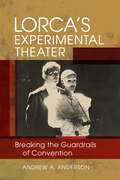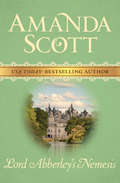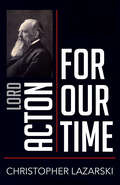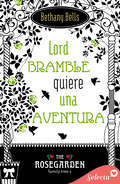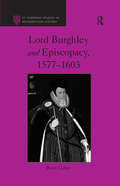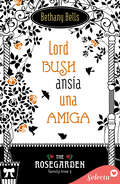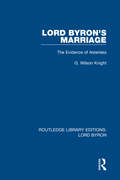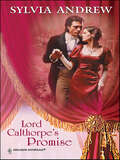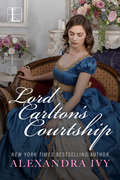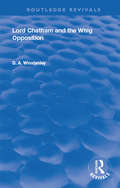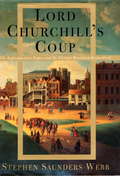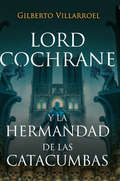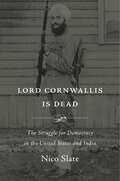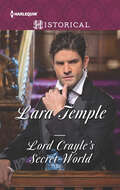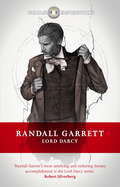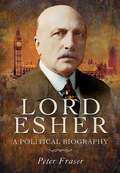- Table View
- List View
Lorca's Experimental Theater: Breaking the Guardrails of Convention (New Hispanisms: Cultural and Literary Studies)
by Andrew A. AndersonCritical and historical discussions of the life and work of Federico García Lorca, Spain’s foremost poet and playwright of the twentieth century, often obscure the author’s more avant-garde dramatic works. In Lorca’s Experimental Theater, Andrew A. Anderson focuses on four of Lorca’s most challenging plays—Amor de don Perlimplín con Belisa en su jardín, El público, Así que pasen cinco años, and El sueño de la vida (previously known as Comedia sin título)—and on the surrounding context in which they came to be written and in only one case performed during his lifetime. While none of Lorca’s plays can be considered conventional, these four works stand out in his corpus for challenging theatrical conventions most forcefully, both thematically and technically.With discussions of stagecraft, artistic modernism, and the historical avant-garde, Lorca’s Experimental Theater provides detailed interpretive readings of the four plays, surveys their textual and performative history, and examines the most important contemporary influences on Lorca’s creation of these expressive, innovative works.
Lord Abberley's Nemesis
by Amanda ScottWinner of the Romance Writers of America&’s Golden Medallion Award: Can a desperate young lady return a rakish earl to respectability? When Miss Margaret Caldecourt returns to her ancestral English country manor from Vienna to care for her late brother&’s six-year-old son and heir, Timothy, she learns that unscrupulous relatives threaten his birthright. Immediately she seeks help from her childhood friend and Timothy&’s newly named guardian, the handsome Adam Fortescue, sixth Earl of Abberley. But Abberley, through reckless pleasure-seeking, has brought scandal to his name, let his estate fall to ruin, and is in no condition to help. Determined nevertheless to enlist his aid and protect her nephew, Margaret decides to reform Abberley&’s heedless ways whether he likes it or not. She knows that beneath his dissolute demeanor lies a noble heart, but never does she suspect that her own heart may be vulnerable to London&’s most notorious rake.
Lord Acton for Our Time (People for Our Time)
by Christopher LazarskiLord Acton for Our Time illuminates the thought of the English historian, politician, and writer who gave us the famous maxim: "Power tends to corrupt, and absolute power corrupts absolutely." Extracting lessons for our current age, Christopher Lazarski focuses on liberty—how Acton understood it, what he thought was its foundation and necessary ingredients, and the history of its development in Western Civilization. Acton is known as a historian, or even the historian, of liberty and as an ardent liberal, but there is confusion as to how he understood liberty and what kind of liberalism he professed. Lord Acton for Our Time provides an introduction that presents essentials about Acton's life and recovers his theory of liberalism. Lazarski analyzes Acton's type of liberalism, probing whether it can offer a solution to the crisis of liberal democracy in our own era. For Acton, liberty is the freedom to do what we ought to do, both as individuals and as citizens, and his writings contain valuable lessons for today.
Lord Bramble quiere una aventura (The Rosegarden Family Tree #Volumen 2)
by Bethany BellsUn lord, una actriz y una puesta en escena única en la que el amor es el auténtico protagonista. Lord Bramble Rosegarden ha recibido un ultimátum de su abuelo: o sienta la cabeza, comprometiéndose de inmediato con una joven de buena familia, o le retirará la asignación con la que mantiene buena parte de sus muchos vicios. Para solucionar el problema, dado que el matrimonio le parece una maldición y no desea todavía atarse a nadie, Bram decide afrontarel problema del modo más astuto que se le ocurre, y contrata a una actriz. Una joven hermosa de la que espera que simule de día ser la más delicada y recatada lady; y que, de noche, caliente su cama en la más ardiente de las aventuras. Tess Newhill adora a Shakespeare y siempre ha soñado con ser actriz, aunque solo la tragedia lo hizo posible. Ahora, a sus veintiséis años, ya ha aprendido que vive rodeada de lobos, y que una joven sola en la vida tiene que estar muy atenta para esquivarlos. Por eso, cuando un joven lord de fama terrible le propone un plan absolutamente descabellado, intenta evitarlo, pero resulta imposible, porque los Rosegarden siempre se salen con la suya. Y Tess se ve obligada a aceptar, claro. Incluso sabiendo que, al hacerlo, va a tener que luchar contra los deseos de su propio corazón.
Lord Braybrook's Penniless Bride
by Elizabeth RollsMiss Christiana Daventry will do whatever it takes to keep from being thrown out on the streets--even accept the insufferably attractive Lord Braybrook's proposition! Julian Trentham, Viscount Braybrook, urgently needs to hire a governess and companion, and Christy is conveniently available. Headstrong, with charmingly mismatched eyes and soft tawny hair, Christy is unlike any woman he has ever encountered. But there is something so deliciously endearing about her that Julian quickly forgets how scandalous it would be to give in to the mounting attraction for his penniless governess. . . .
Lord Bredon and the Bachelor’s Bible (The House of Lovell #2)
by Mia MarloweWith the dowries of all the season’s debutantes exposed in its scandalous pages, The Bachelor’s Bible is a handy tool for an earl in need of an heiress . . . Edward Lovell, newly minted earl, bears a weighty responsibility: to restore his family’s estate to its former grandeur. The task requires not simply a wife, but a wealthy one. Thanks to The Bachelor’s Bible, he already has a particular lady in mind. He has only to convince her sponsor that he will make a suitable husband. There’s just one complication: the sponsor is none other than the only woman he’s ever loved—and inexplicably lost. Now a young widow, Lady Anne Howard is more beautiful than ever . . . Anne is not about to be taken for a fool a second time. When they last met, Edward was Lord Bredon, the man she adored—the man who destroyed her dreams of a happy future. Now he is pursuing the hand of the young lady Anne must keep safe from unscrupulous suitors. But who will protect Anne from the earl who still possesses her heart?. . . “Mia Marlowe is the mistress of saucy historical romances.”—Books Monthly “Mia Marlowe is a rising star!” —New York Times Bestseller Connie Mason “Mia Marlowe proves she has the ‘touch’ for strong heroines, wickedly sexy heroes!”—Jennifer Ashley, USA Today bestselling author of Lady Isabella’s Scandalous Marriage “Her three-dimensional characters truly steal readers’ hearts and keep the pages flying.” —Kathe Robin “A delightful Regency romance, full of passion, humor, and love.”—Ella Quinn, USA Today bestselling author
Lord Burghley and Episcopacy, 1577-1603 (St Andrews Studies in Reformation History)
by Brett UsherLord Burghley and Episcopacy, 1577-1603 examines the selection and promotion of bishops within the shifting sands of ecclesiastical politics at the Elizabethan court, drawing on the copious correspondence of leading politicians and clerical candidates as well as the Exchequer records of the financial arrangements accompanying each appointment. Beginning in 1577, the book picks up the narrative where Brett Usher's previous book (William Cecil and Episcopacy, 1559-1577) left off, following the fall of Archbishop Grindal, which brought the Elizabethan church to the brink of disaster. The book begins with an outline of the period under review, challenging the traditional view of corruption and decline. Instead Usher provides a more complex picture, emphasizing the importance of court rivalries over patronage and place, and a broadly more benign attitude from the Exchequer, which distinguishes the period from the first half of the reign. Within this milieu the book situates the dominance of the Cecils - father and son - in ecclesiastical affairs as the key continuity between the two halves of Elizabeth's reign. Providing a fresh analysis of the Burghley's long and influential role within Elizabethan government, Usher both illuminates court politics and the workings of the Exchequer, as well as the practical operation of Elizabeth's supremacy. Specifically he demonstrates how Elizabeth learnt a valuable lesson from the debacle over the fall of Grindal, and from the late 1570s, rather than taking the lead, customarily she looked to her councillors and courtiers to come to some accommodation with each other before she would authorize appointments and promotions. Note: Brett Usher died in 2013 before the publication of this book. Final editing of the typescript was undertaken by Professor Kenneth Fincham of the University of Kent, who also guided the book through the publication process.
Lord Burghley and Episcopacy, 1577-1603 (St Andrews Studies in Reformation History)
by Brett UsherLord Burghley and Episcopacy, 1577-1603 examines the selection and promotion of bishops within the shifting sands of ecclesiastical politics at the Elizabethan court, drawing on the copious correspondence of leading politicians and clerical candidates as well as the Exchequer records of the financial arrangements accompanying each appointment. Beginning in 1577, the book picks up the narrative where Brett Usher's previous book (William Cecil and Episcopacy, 1559-1577) left off, following the fall of Archbishop Grindal, which brought the Elizabethan church to the brink of disaster. The book begins with an outline of the period under review, challenging the traditional view of corruption and decline. Instead Usher provides a more complex picture, emphasizing the importance of court rivalries over patronage and place, and a broadly more benign attitude from the Exchequer, which distinguishes the period from the first half of the reign. Within this milieu the book situates the dominance of the Cecils - father and son - in ecclesiastical affairs as the key continuity between the two halves of Elizabeth's reign. Providing a fresh analysis of the Burghley's long and influential role within Elizabethan government, Usher both illuminates court politics and the workings of the Exchequer, as well as the practical operation of Elizabeth's supremacy. Specifically he demonstrates how Elizabeth learnt a valuable lesson from the debacle over the fall of Grindal, and from the late 1570s, rather than taking the lead, customarily she looked to her councillors and courtiers to come to some accommodation with each other before she would authorize appointments and promotions. Note: Brett Usher died in 2013 before the publication of this book. Final editing of the typescript was undertaken by Professor Kenneth Fincham of the University of Kent, who also guided the book through the publication process.
Lord Bush ansía una amiga (The Rosegarden Family Tree #Volumen 3)
by Bethany BellsCuando los sentimientos entran en conflicto, el amor siempre sabe encontrar el camino. Lord Bush Rosegarden nunca ha sentido que encajase en su familia. Aunque se sabe atractivo, carece de la belleza oscura de sus hermanos y de su sentido perverso de afrontar la vida. A diferencia de ellos, es serio, formal, no concibe la idea de perder el tiempo con diversiones vacías y solo cuenta con un amigo de verdad, Henry Claredon. Bush y Claredon siempre han querido ser médicos, una profesión que los hace sentir bien, porque les resulta grato ayudar a otros y procurarles un poco de alivio y alegría en los malos momentos. Han estudiado juntos y ahora trabajan con un médico, adquiriendo práctica. Pero, todos los proyectos de vida de Bush, tan claros, ordenados y perfectos se rompen en mil pedazos cuando sus ojos se encuentran con los de la señorita Caroline Mildmay, la prometida de su amigo.Caroline Mildmay llega a Londres acompañada de su tía para casarse con el hombre al que ha estado siempre prometida. Es feliz, quiere a Henry, siempre lo ha querido, pero todo se complica cuando conoce a lord Bush y se da cuenta de que ese amor que sentía no era más que una sombra de lo que solo ahora empieza a experimentar.
Lord Byron and Scandalous Celebrity
by Clara TuiteThe Regency period in general, and the aristocrat-poet Lord Byron in particular, were notorious for scandal, but the historical circumstances of this phenomenon have yet to be properly analysed. Lord Byron and Scandalous Celebrity explores Byron's celebrity persona in the literary, social, political and historical contexts of Regency Britain and post-Napoleonic Europe that produced it. Clara Tuite argues that the Byronic enigma that so compelled contemporary audiences - and provoked such controversy with its spectacular Romantic Satanism - can be understood by means of 'scandalous celebrity', a new form of ambivalent fame that mediates between notoriety and traditional forms of heroic renown. Examining Byron alongside contemporary figures including Caroline Lamb, Stendhal, Napoleon Bonaparte and Lord Castlereagh, Tuite illuminates the central role played by Byron in the literary, political and sexual scandals that mark the Regency as a vital period of social transition and emergent celebrity culture.
Lord Byron's Marriage: The Evidence of Asterisks (Routledge Library Editions: Lord Byron #6)
by G. Wilson KnightFirst published in 1957. This title explores the brief marriage of Lord Byron and his wife Annabella Millbanke, and the scandal that surrounded their relationship. The exact reason for their separation and eventual divorce was never confirmed, but G. Wilson Knight uses Byron’s poetry, letters and other published works to develop and expand the theories of other literary critics. This title will be of interest to students of literature.
Lord Calthorpe's Promise
by Sylvia AndrewAn Honorable PromiseLord Adam Calthorpe had been rash in his promise to look out for a fellow soldier’s sister before the soldier was killed at the battle of Waterloo. For Miss Katherine Payne was a golden-eyed shrew who took genuine delight in flouting Adam’s authority at every turn.Surely bringing her to stay with his mother for the Season would absolve him of his responsibilities-though he sincerely doubted such a headstrong young woman would ever find herself a husband in the marriage mart. But when an unscrupulous man starts pursuing Katherine, Adam comes to realize that fulfilling his promise might actually involve marrying her himself....
Lord Carlton's Courtship
by Alexandra IvyWhen a lady goes looking for her missing brother, the adventure leads to dangerous desire in this Regency romance by the New York Times bestselling author. Miss Roma Allendyle detested behaving like a proper lady, and all the patronizing nonsense that came along with it. After all, she could outride and outshoot any gentleman. When her brother, an agent of the Crown, suddenly vanishes, she sees no reason not to go looking for him herself—even if doing so requires her to disguise herself as a grubby lad. Roma expects to face challenges, but not to be targeted by a mysterious ambush. Nor did she expect to be rescued by the darkly handsome Lord Giles Carlton, the Season&’s prime catch. Though she is grateful to be alive, Roma is incensed by Giles&’s arrogance—especially when he insists on helping with her search. But there is yet another surprise in store. For in Giles, Roma just may find a will and passion to match her own—and an outlandish ploy that could lead to true love.
Lord Chatham and the Whig Opposition (Routledge Revivals)
by D. A. WinstanleyOriginally published in 1966, this book examines the struggle between the whig factions and the crown during a period of George III's reign. During the short period, the destinites of the nation were determined and the work of the Revolution nullified; never before had the opponents of personal government been given such a favourable opportunity to thwart the execution of the royal schemes, and yet they failed hopeleslly. Lord Chatham and the Whig Opposition includes chapters covering the formation of Chatham's administration, the rise and fall of the opposition, and its downfall.
Lord Churchill's Coup: The Anglo-American Empire and the Glorious Revolution Reconsidered
by Stephen S. WebbIn LORD CHURCHILL’S COUP, Stephen Saunders Webb further advances his revisionist interpretation of the British Empire in the seventeenth century. Having earlier demonstrates that the Anglo=American empire was classic in its form, administered by an army, committed to territorial expansion, and motivated by crusading religion, Webb now argues that both England and its American social experiments were the underdeveloped elements of an empire emerging on both sides of the Atlantic and that the pivotal moment of that empire, the so-called “Glorious Revolution,” was in fact a military coup driven by religious fears. <P><P> In a vigorous narrative, Webb populates this formative period of the Anglo-American past with colorful and commanding characters. At the center is John Churchill. We see him rise from page boy to earl of Marlborough, winning battlefield glory, influence, and promotion; and his corresponding rise from ensign of the English army taking control of the destiny of the later Stuart monarchs of Britain and America. <P> Webb shows us Churchill increasingly alarmed by the Catholicizing course of his patron, James II, and becoming instrumental in the organization of a successful coup to protect Anglicanism and the constitution. We see the resulting alliance with William of Orange, the Protestant champion of Europe, quickly turn sour as William makes himself king; and we see Churchill, now transformed into imperial politician, once again in power—able to secure the succession of Queen Anne and negotiate the terms of resumption of war against France. <P> Throughout, Webb makes it clear that at the heart of Churchill’s ascent and actions is his vision of America as a decisive factor in the world war between England and France for impersonal supremacy. As the book ends, Churchill’s American agenda thus becomes central to the war aims of the Grand Alliance.
Lord Cochrane en las montañas
by GILBERTO VILLARROELEl audaz marino encuentra un mundo subterráneo bajo las tierras del sur de Chile. Las coordenadas del corsario Selkirk llevan a Lord Cochrane y sus acompañantes hasta una cadena montañosa, los Cuernos del Diablo, ubicada al norte del Estrecho de Magallanes. Esta resulta ser la entrada a un monumental túnel que conduce, bajo el Mar de Drake, hasta Deception Island, en territorio antártico. El audaz marino ensambla su prototipo de locomotora, The Rocket, y a bordo de ella inicia el descenso hacia aquel mundo subterráneo, que fue el primer hogar en la Tierra del dios Cthulhu. Pero las Montañas de la Locura no están desiertas. Bajo ellas vive todavía una raza ancestral de científicos: los Antiguos. Y un puñado de piratas, encabezados por el capitán Corrochano, un viejo enemigo de Cochrane, amenaza la vida de The Sea Wolf y los suyos. ¡Lord Cochrane, Maria Graham y el capitán Eonet enfrentarán peligros mortales en este arriesgado viaje a través de terra incognita!
Lord Cochrane y la hermandad de las catacumbas
by Gilberto Villarroel¡El marino más audaz de todos los tiempos vivirá una nueva aventura! Francia, 1826. Lord Cochrane recibe un mensaje de auxilio del profesor Jean-François Champollion, jefe de la Sección de Antigüedades Egipcias del Museo del Louvre. Él ha descubierto un testimonio escrito por Julio César en el 52 a.C., que podría ser la clave sobre la primera aparición del dios extraterrestre, Cthulhu. Pero alguien más está detrás de ese manuscrito; una misteriosa hermandad secreta, encabezada por una alta figura de la Iglesia. Y está dispuesta a todo por conseguirlo. Cochrane deberá luchar entonces contra este nuevo enemigo: los poderosos seguidores de un culto siniestro. ¿Qué peligros encontrará en los cementerios,catedrales y catacumbas de París? Reseña: "La novela tiene una profunda investigación, privilegiando los detalles históricos, la ambientación y una muy cuidada atmósfera." Jorge Baradit
Lord Cornwallis Is Dead: The Struggle for Democracy in the United States and India
by Nico SlateDo democracies bring about greater equality among their citizens? India embraced universal suffrage in 1947 and yet its citizens are far from realizing equality. The U.S. struggles with intolerance and inequality well into the twenty-first century. Nico Slate offers a new look at the struggle for freedom that linked two former British colonies.
Lord Crayle's Secret World: The Secrets Of Wiscombe Chase An Earl In Want Of A Wife Lord Crayle's Secret World (Mills And Boon Historical Ser.)
by Lara TempleA desperate highwaywoman’s attempt to rob a dashing spymaster leads to an enticing arrangement in this thrilling Regency romance.Holding a lord at gunpoint, Miss Sari Trevor wonders how it came to this. One look into the icy gray eyes of Michael D’Alency Alistair, Earl of Crayle, and she knows she’s out of her depth. But then, this enigmatic lord makes Sari a mysterious offer of employment . . .Although she challenges his rigid self-control, Sari is perfect for the secret agency of spies Michael manages. But helping tutor this daring beauty proves to be a sensual assault Michael isn’t prepared for . . . and a temptation neither can resist!
Lord Darcy (FANTASY MASTERWORKS)
by Randall GarrettWelcome to a world where the Plantagenet kings survived, the laws of magic were discovered and the physical sciences never pursued. In the resulting Anglo-French Empire, a detective like Lord Darcy needs more than a keen mind and an observant eye. Luckily, Darcy can call on the aid of Master Sean O'Lochlainn, forensic sorcerer.This omnibus contains all of the Lord Darcy stories as well as the only Lord Darcy novel, TOO MANY MAGICIANS, and has a new introduction by Michael Dirda.
Lord Dashwood Missed Out: A Spindle Cove Novella
by Tessa DareA snowstorm hath no fury like a spinster scornedMiss Elinora Browning grew up yearning for the handsome, intelligent lord-next-door...but he left England without a word of farewell. <P><P>One night, inspired by a bit too much sherry, Nora poured out her heartbreak on paper. Lord Dashwood Missed Out was a love letter to every young lady who'd been overlooked by gentlemen--and an instant bestseller. Now she's on her way to speak in Spindle Cove when snowy weather delays her coach. She's forced to wait out the storm with the worst possible companion: Lord Dashwood himself.And he finally seems to have noticed her.George Travers, Lord Dashwood, has traveled the globe as a cartographer. He returned to England with the goal of marrying and creating an heir--only to find his reputation shredded by an audacious, vexingly attractive bluestocking and her poison pen. Lord Dashwood Missed Out, his arse. Since Nora Browning seems to believe he overlooked the passion of a lifetime, Dash challenges her to prove it.She has one night.
Lord Deverill's Secret
by Amanda GrangeA delightful tale of romance and intrigue from the acclaimed author of Mr. Knightley's Diary. Arriving in Brighton, Cassandra Paxton had one important task-to uncover the meaning of a letter she'd found amidst her late brother's belongings. She knew of only one man who could help her: Lord Deverill, who just happened to be the most eligible bachelor in all of Brighton. But what she didn't realize-until it was too late-was that the handsome earl had a secret of his own. One that might prevent him from telling her the truth-and one that made a marriage between them impossible. Which was most unfortunate, considering the way his gentle touch made Cassandra's pulse quicken.
Lord Dufferin, Ireland and the British Empire, c. 1820–1900: Rule by the Best? (Routledge Studies in Modern British History)
by Annie TindleyThis book explores the life and career of Frederick Temple Hamilton-Temple-Blackwood, 1st Marquess of Dufferin and Ava (1826–1902). Dufferin was a landowner in Ulster, an urbane diplomat, literary sensation, courtier, politician, colonial governor, collector, son, husband and father. The book draws on episodes from Dufferin’s career to link the landowning and aristocratic culture he was born into with his experience of governing across the British Empire, in Canada, Egypt, Syria and India. This book argues that there was a defined conception of aristocratic governance and purpose that infused the political and imperial world, and was based on two elements: the inheritance and management of a landed estate, and a well-defined sense of ‘rule by the best’. It identifies a particular kind of atmosphere of empire and aristocracy, one that was riven with tensions and angst, as those who saw themselves as the hereditary leaders of Britain and Ireland were challenged by a rising democracy and, in Ireland, by a powerful new definition of what Irishness was. It offers a new perspective on both empire and aristocracy in the nineteenth century, and will appeal to a broad scholarly audience and the wider public.
Lord Edgware Dies: A Hercule Poirot Mystery (Hercule Poirot Mysteries #9)
by Agatha ChristieWhen Lord Edgware Dies a most unnatural death, detective Hercule Poirot must solve a most confounding conundrum: if the obvious killer, the slain peer’s spiteful wife, didn’t do it, who did? A classic from the queen of mystery, Agatha Christie.When Lord Edgware is found murdered the police are baffled. His estranged actress wife was seen visiting him just before his death and Hercule Poirot himself heard her brag of her plan to “get rid” of him.But how could she have stabbed Lord Edgware in his library at exactly the same time she was seen dining with friends? It’s a case that almost proves to be too much for the great Poirot.
Lord Esher: A Political Biography
by Peter FraserAlthough wielding huge influence in late Victorian and Edwardian political life, Reginald Baliol Brett (1852 1930), the second Lord Esher was, an enigma to his contemporaries and still remains a puzzle to historians.At the heart of British and Imperial political affairs for several decades, Esher sat in both Houses of Parliament, was a high ranking civil servant, friend and confidential advisor to three Sovereigns and four Prime Ministers (of differing political hues) and yet refused high office offered by both Liberals and Conservatives. Yet his behind-the-scenes influence through his range of friends in high places gave him unmatched, some thought undemocratic, power. Despite his lack of military service he was instrumental through his work on the Committee for Imperial Defence (CID) and its Secretarial for the wholesale reorganisation of the Armed Forces. It could be said that Esher, with his grasp of power without responsibility, was a unique phenomenon in British history.The Author, while compiling this fascinating study, drew on Cabinet and CID files, the Royal Archives and the papers of the Esher, Balfour, Asquith and Lloyd George estates. The result is a brilliant readable yet scholarly addition to British political bibliography.
